-
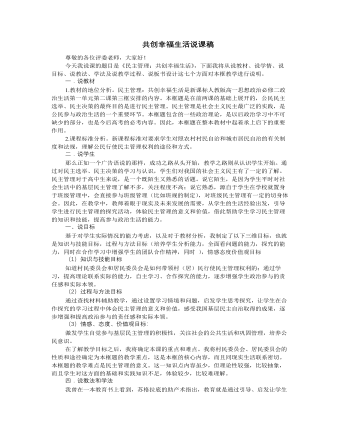
人教版高中政治必修2共创幸福生活说课稿
环节三 案例分析 突破难点我将用多媒体展示两组反映中学生参与民主管理的一些作法的图片,和教材26-27页的三个镜头,然后请同学们根据图片和材料探究以下问题: 1. 联系自身实际谈谈这些做法对我们有何启示? 2.实行农村村民自治和城市居民自治有什么意义呢? 3. 我们在实际生活中应怎么做?这样,通过图片和材料的展示,点明了公民参与民主管理的意义,以此来诱发学生已有的真切体验,感受其境,增强学生共创想和文明社区的积极性和情感。同时,我们也希望学生在学习本课的知识后,又能做到学以致用,把所学的知识真正用到社区管理中,为所在社区管理提合理建议,从而真正实现了知识从生活中来,又回到生活中去的理念。环节四课堂小结 课后延伸将用多媒体展示本节课的知识框架,并注重引导学生将今天所学新知识与前面知识联系起来,帮助学生从宏观上把握各知识点之间的关系,有利于学生理解记忆,以此来帮助教师在第一时间掌握学生学习信息的反馈,同时培养学生归纳分析能力、概括能力。
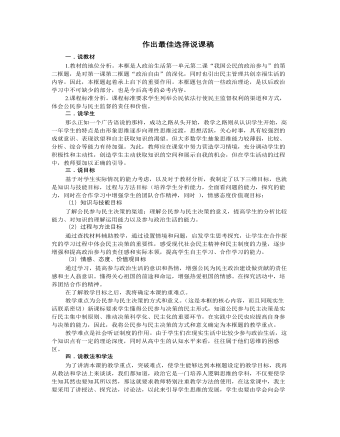
人教版高中政治必修2作出最佳选择说课稿
环节四 模拟演练 情感升华我将让同学们阅读课本22页的材料,并按照所提供的步骤,组织学生举办一次模拟听证会,将学生分为四个小组,分别扮演教育局工作人员、人大代表、学生家长、学校校长的角色。待学生们模拟听证会结束后,我将采访学生,让他们谈谈参加完听证会后的感受,从而利用角色感悟总结落实民主决策的重大意义。这样,学生们在模拟演练中,感悟公民要通过各种渠道参与民主决策,是推进决策科学化、民主化的重要环节。为学生将来参与政治生活积累经验,增强了学生的主人翁意识和社会责任感。环节五 课堂小结 课后延伸我将用多媒体展示本节课的知识框架,并注重引导学生将今天所学新知识与前面知识联系起来,帮助学生从宏观上把握各知识点之间的关系,有利于学生理解记忆。另外,适当的课堂练习能检验学生掌握知识的情况,因此,课堂小结后我将让学生做一些典型的练习,加深学生对本课知识的理解,同时为为下一课的学习做准备。

人教版高中政治必修3感受文化影响说课稿
(2)世界观,人生观,价值观是人们文化素养的核心和标志。一旦形成就会对人产生深远持久的影响。(但随着生活阅历的变化,人们文化素养的提高,人们的“三观”会发生变化。)总之“潜移默化”指每时每刻,不知不觉;是从文化对人影响的过程来看的。“深远持久”指经年累月,难以抹去;是从文化对人影响的结果上说的。3.课堂总结:首先启动学生思维,教会学生把握知识主线,建构知识体系,先由学生进行总结,然后教师进行必要的补充4、布置作业:布置作业。运用文化对人的影响的知识分析“近朱者赤,近墨者黑”,并且应该如何处理朋友之间的关系。设计这个作业的意图是既让学生灵活运用所学知识,同时又让学生回归生活,如何处理朋友之间的关系。5、板书设计遵循板书设计的实用性、直观性的原则,根据本课的教材特点,我采用结构式板书,这样设计比较直观、系统,以便于学生能够系统把握和理解知识。
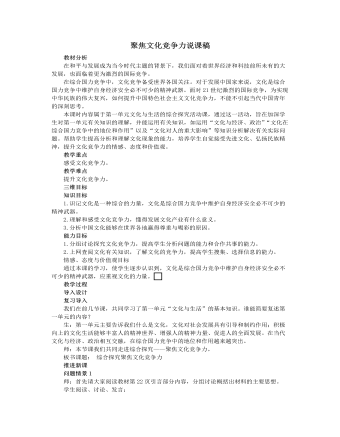
人教版高中政治必修3聚焦文化竞争力说课稿
(1)文化与经济、政治在经济基础上相互影响。①经济、政治和文化是社会生活的三个基本领域。其中,经济是基础,政治是经济的集中表现,文化是经济和政治的反映。一定的文化由一定的经济、政治所决定,又反作用于一定的政治、经济,给予政治、经济以重大影响。②经济发展是文化发展的基础。但这并不意味着文化的发展始终与经济的发展亦步亦趋。如同不能简单地把精神文明看作是物质文明的派生物和附属品一样,也不能简单地认为文化是经济、政治的派生物和附属品。文化有其自身的传承性和相对的独立性。那种认为只要物质条件好了,精神文化自然而然地就会好起来,物质条件差一点,精神文化就不可能搞好的观点,不符合历史发展的事实,是不正确的。③掀开历史的画卷,文化既有古今和地域之别,又有先进与落后、腐朽之分。不同的文化,对经济、政治的影响不同,对社会发展的作用也不同。不同民族的文化,影响不同民族和国家各具特色的发展道路。
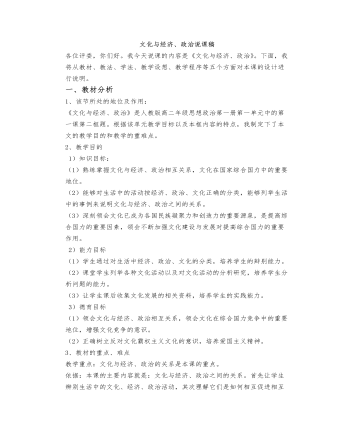
人教版高中政治必修3文化与经济、政治说课稿
(二)讲授新课:1、讲授重点:文化与经济、政治的关系。我首先带领学生分析课本上的活动探究,了解日常生活中的常见活动,让学生们观看视频材料帮助学生对文化活动、经济活动、政治活动进行辨别和分类。然后让学生们举例说明,综合探究,最后通过集体讨论得出文化与经济政治的关系:经济是基础,政治是经济的集中表现,文化是经济和政治的反映,一定的文化由一定的经济和政治决定,又反作用于政治和经济。这个问题是本课重点。要引导学生循序渐进,集体讨论,得出结论。2、突破难点:(1)文化与经济政治相互交融,在时代发展的进程中。首先播放上海世博会视频,让学生体会文化、经济、政治活动,另外我会引导学生积极举生活中的事例,来说明问题,让学生学会举一反三,充分理解这一知识,让学生明白文化与经济、政治的联系,让学生清楚文化渗透的力量有多大,帮助学生树立反对文化霸权主义的意识。
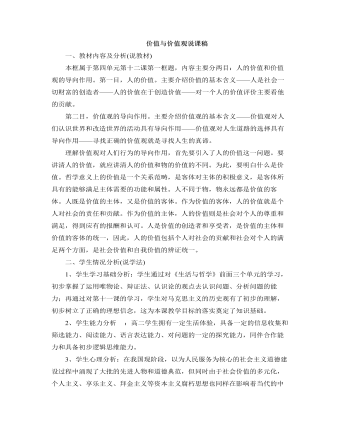
人教版高中政治必修4价值与价值观说课稿(二)
二、学生情况分析(说学法)1、学生学习基础分析:学生通过对《生活与哲学》前面三个单元的学习,初步掌握了运用唯物论、辩证法、认识论的观点去认识问题、分析问题的能力;再通过对第十一课的学习,学生对马克思主义的历史观有了初步的理解,初步树立了正确的理想信念,这为本课教学目标的落实奠定了知识基础。 2、学生能力分析 :高二学生拥有一定生活体验,具备一定的信息收集和筛选能力、阅读能力、语言表达能力、对问题的一定的探究能力,同伴合作能力和具备初步逻辑思维能力。3、学生心理分析:在我国现阶段,以为人民服务为核心的社会主义道德建设过程中涌现了大批的先进人物和道德典范,但同时由于社会价值的多元化,个人主义、享乐主义、拜金主义等资本主义腐朽思想也同样在影响着当代的中学生。

人教版高中政治必修4生活处处有哲学说课稿
(二)组织学生探究知识并形成新的知识。我从学生的生活体验入手,运用案例等形式创设情境呈现问题,使学生在自主探索、合作交流的过程中,发现问题、分析问题、解决问题,在问题的分析与解决中主动构建知识。主要通过几幅漫画让学生思考其中的哲学道理,开始接触哲学。漫画一:种瓜得瓜,种豆得豆,种鸡蛋得??漫画二:甲:下雨好极啦!乙:下雨糟透了!漫画三:——狂妄之徒,你竟然坏了祖上规矩!在引导学生思考、体验问题的过程中,可以使学生逐步学会分析、解决问题的方法。这样做既有利于发展学生的理解、分析、概括、想象等创新思维能力,又有利于学生表达、动手、协作等实践能力的提高,促进学生全面发展,力求实现教学过程与教学结果并重,知识与能力并重的目标。

人教版高中英语必修4Body Language说课稿4篇
Textbook: Senior English for China (Book 4), by Liu Daoyi Time Allotment: 1 period (40 minutes)Date: March 20, 2014Teaching aids: blackboard, Multi-media, Power Point, chalk I. Text Analysis (教材分析)This unit is about body language, and the text selected in the reading part demonstrates the difference and similarity of body language in many parts of the world. Through learning this passage, students are required to raise their awareness of using body language in different parts of the world. As body language is closely related to our daily life, it is easy to arouse students’ interest in learning this text. Reading skills and speaking training are designed around the text.II. Teaching Objectives (教学目标)By the end of the lesson, students will be able to:1. Language Skill Objective(语言技能目标): develop reading ability (skimming and scanning)as well as speaking ability.2. Cultural Knowledge Objective(文化知识目标): know about the cultural differences of using body language.3. Affective Objective(情感目标): increase students’ awareness of using body language correctly in different cultures. III.Teaching Focuses and Difficulties(教学重点和难点)1. Teaching Focuses(教学重点): the difference and similarity of body language in many parts of the world.2. Teaching Difficulties(教学难点): develop students’ reading abilities of skimming and scanning and ask the students to show their opinions with fluent English.

人教版高中英语必修3Astronomy the science of the stars说课稿3篇
Step 2 Pre-listeningAfter students finish their discussion, I will show a picture of Newton and ask them: Who is him? What is he famous for? Could you find out some words to describe him? Maybe students will answer that he is genius for his finding of theGravitation, making a great contribution to the progress of human being. At that time I will show another two pictures of Einstein and Hawking, letting students guess who they are and write down their idea about the Gravitation. For I have arranged them to search more information about the gravity before this class, Students have beenfamiliar with the topic and will not be afraid about this abstract conception, which is helpful for their listening.Step 3 While-listeningIn this step, students will be required to listen the material for three times. The first and listening is extensive listening and the second and third listening is intensive listening. In the first time, They are required to listen a material including Part 1 and Part 2 and choose the best summary of the listening text. After they choose the right answer, They also need work in group to explain what is wrong with the others. Then I will make a conclusion that we should pay attention to the first paragraph and last paragraph and some keys to get the main idea. By doing this, their capacity of generalization will have a great improvement.Before the second listening, I will ask students to scan the blank on the power point quickly and ask them to note down some key words .Then ask them to listen to the Part 1again and fill the first column of the chart. Maybe some students just show the ideas of these three scientists an still can’t catch their development of gravity. Therefore, I will ask them to listen to Part 2 again and fill in the rest. After finish the listening, I will give them ten minutes to discuss with their partner. I will also guidethem to improve their answers when they discuss with others.

人教版高中英语必修4A taste of English Humor说课稿3篇
Then I would ask them to think of a funny English or Chinese and tell it to partners. While telling stories, they can use expressions and some acting to help make the story funny. 5 minutes would be given to do this.Those stories they told there will be the material for their writing. Soletting them tell it at first is helpful. And they can make a difference between telling a funny story and writing it down. Generally speaking, it is difficult forstudents to write well because they don’t know what to write and how to write. Asking them to tell their own stories at first can help them come up with what to write.After their telling, I would invite someone to share his/her story with all of us and I would write it down on the blackboard.This example story would be used as a sample to illustrate the format of funny story. Different from a story from teacher or textbook, a story from students can obviously become a interesting material to draw students’ attention.Then I would ask the whole class to put this story into several parts. It might be a little bit difficult for them. So I would ask them to find out whether all the sentences are necessary. After delete some sentences, there are 6 sentences left behind. Then they can easily put them into three parts. After interaction with students, I would teach them the right terms for each part and conclude the format of funny story.This step is the key and difficult point in my lesson. So I mainly usetask-based teaching method in this part and the task for students was divided into several stages. With the separated difficult level, students can find there are usually three parts in writing. They can also learn to write without the unnecessary parts in the process of analyzing. And then I wouldn’t rush to tell them the right terms to them directly. Instead, I would ask them to name them by their own. A confused mind is better for acquiring knowledge.While-writing:Then I would give students 7 minutes to write down this story, without other requirements.With all the preparations in pre-writing, students’ difficulties were cleared. So it would be much easier for them to write down the story within 7 minutes. There are no other requirements because students’ first writing is actually a drafting. It would be revise and edit several times later. Writing, as a skill

人教版高中英语必修4Women of achievement说课稿4篇
Good morning, distinguished judges:It’s my honor to talk about my teaching ideas with you. Today my topic is Women of Achievement. My presentation consists of six parts: the analysis of teaching material and student, teaching aims, key and difficult points, teaching and studying method, teaching procedures and blackboard design.First, let’s focus on the analysis of teaching material. This lesson is from New Senior English for China Student’s Book 4 Unit 1, the reading part. The main topic of the passage is the introduction of a student of Africanwildlife. After this lesson, the students will learn more information about her studying chimps in Africa, and their reading and speaking abilities can be developed as well.The next part is the analysis of students. My students are in senior high students. They have learnt English for many years, they’ve known many words and sentences, but their speaking and reading abilities are still not very good. So I will practice their speaking and reading abilities through different exercises.According to the New Standard Curriculum and the present situation, I set the teaching aims as follows: firstly, knowledge aims. Students can grasp some new words, such as worthwhile, move off. Moreover, students can understand the content of the passage and get familiar with the topic of studying chimps in wildlife. Secondly, ability aims. Students can use reading strategies such as skimming and scanning in reading process. Thirdly, emotional aims. Students can have the awareness of protecting animals and care about animals.Based on the above analysis, the key point of this lesson is to get the main idea and the detailed information from the passage; the difficult point is to talk about the wildlife protection and use reading strategies.

人教版高中英语必修4Theme parks说课稿3篇
The oldest and the most popular park in the worldenjoy the exciting activities thereget close to the life-size cartoon characters like Mickey Mouse and Donald Duck Step 3 Pre-reading1.What do you suppose a theme park is ?2.What do you think you can see in a theme park?(1.It is a kind of amusement park which has a certain theme – that the whole park is based on. 2.buildings, castles, statues, rare animals and birds, and so on.) Step 4 Reading ----- Theme Parks –---- Fun and More Than Fun1.Predict : Read the title and the pictures on P. 34 and PredictWhat is the meaning of the title “Theme Park – Fun and more than fun”?(The title means that theme parks are fun to visit, but that they can also be educational and can offer useful information.)2.Skimming Fast read and answer:What activities can we take in a theme park?Amusement park: Bumper car Merry-go-round slide bungee jumping Free-fall rides Horror films Pirate ship Ferris wheel roller coaster3.Scanning Read again and you will find various theme parks are mentioned in the passage . Then what are they ?Theme parks: Sports theme park History theme park Culture theme park Marine or Ocean theme Park Future park Science theme park Disneyland4.Careful reading and find the main idea of each paragraph:THEME PARKS---- entertaining/ educationalPara.1 Traditional parks are places to go for relaxation and to have time away from our busy lives.Para.2 Theme parks are different They’re large and full of things to do, see and buy.Para.3 Theme parks are built around a single idea or theme. One example is a sports park.Para.4 Another kind of theme park is historical more and cultural and can be educational.Para.5 Disneylandwas the first theme park. It is based on the fantasy life and characters of Disney’s films.Para.6 Some examples of educational theme parks include sea world parks and science parks.

人教版高中英语必修4Working The Land说课稿3篇
Knowledge objectives:(1) to make Ss grasp the usage of words, expressions and sentence structures: statistics, struggle, thanks to, rid of, some patterns for persuasion, the “ing” form as subject and object;(2)to use learnt knowledge to persuade sb.Ability objectives:(1) to develop Ss’ reading skills(skimming, scanning, word guessing);(2) to improve Ss’ speaking, communicating and cooperating skills.Emotional objectives:to make Ss know the contribution of Yuan,and learn his spirit and his simple life time.Teaching important and difficult points:(1) some words, expressions and sentence structures mentioned above;(2)the content of the text;(3)training their reading and speaking skills.Teaching methods: CLT, TBLT,QT.Learning strategies: CLS, QLS, TBLS.Teaching procedures:Step 1 lead-in: (1) teacher plays a piece of recent news from CCTV about the harvest of the super hybrid rice, and ask students whether they know Yuan or not, and talk about him and his contribution.(2)Brain storm: let Ss describe Yuan in their minds including his appearance, his living condition and so on.Step 2 fast reading tasks:(1)teacher introduces Yuan and super hybrid rice(2)make Ss read the text as fast as possible with questions. Such as: what’s the general ideaof this passage? What’s Yuan’ dream? (skimming and scanning skill)Step 3 intensive reading tasks(1)let Ss read the text silently, find topic sentence of each paragraph and draw the difficult sentences and the knowledge what they don’t understand.(words guessing)(2)teacher and Ss talk about the important words, expressions and sentences together, and ask Ss to retell the content of the text.(summarizing and paraphrasing)(3)teacher summarize this part.(4) read again following the courseware.

人教版高中英语必修5Great scientists说课稿4篇
通过写文章梗概,培养学生综合运用语言的能力,学习用恰当的英语描述科学家的故事。这是本课的教学难点。教师可以使用完形填空的方式来帮助学生整理语篇,从而来降低难度。本课的教学重点的突破方法是:在阅读前,让学生初步了解得出科学观点所需要的基本程序,从而轻松而自然地导入文章的阅读;在阅读过程中,由易到难设计快速阅读和精读的问题,层层推进各种阅读活动,让学生对阅读内容从整体感知到细节理解,最后深层读懂整篇文章,同时加强阅读策略的指导,让每个学生都主动参与课堂教学活动,最终达到提高阅读能力的目的。Step 4 Post-readingGroup Activities四人小组共同合作,在老师的适当指导下,就以下2个问题展开讨论,让学生就所知、所学、所感和所想融入话题,然后抽若干同学代表作小组发言。1. What do you think about John Snow, and what should we learn from him?2. Cholera was 19th century disease, which two diseases are similar to cholera today? Why?

人教版高中英语必修5Life in the Future说课稿5篇
Good afternoon, everyone. It’s my great pleasure to be here sharing my lesson with you. The content of my lesson is Senior English for China Book5 Unit 3 Life in the Future. I’ll be ready to begin this lesson from six parts: Analysis of the teaching material, Analysis of the students, Teaching aims and important and difficult points, Teaching methods and aids, Teaching procedures, and Blackboard design. First, let me talk about the teaching material.Part 1 Analysis of the Teaching Material:This unit is about what human beings’ life will be like in about one thousand years. By studying of this unit, we’ll Enable the students to know the changes in humans’ life and some new inventions bringing about the change and develop the interest in science. This lesson plays an important part in the English teaching in this unit. This is an important lesson in Book Five. From this lesson, it starts asking the Ss to grasp contents of each passage. Therefore, this lesson is in the important position of the teaching material. If the Ss can learn it well, it will be helpful to make the Ss learn the rest of this unit.Part 2 Analysis of the SsAs Senior2 Ss, they are at different levels of English fluency, some of them have lost interest in English. So during the lesson, I arrange a variety of activities to let all of them join in to attract their interest and let them be confident and taste the joy of success.

人教版高中语文必修2《囚绿记》说课稿2篇
“深入探究,把握主旨”这一步则是解决教学的重点难点,这里涉及到课文的深层意蕴,学生理解有难度,教师在通过问题引领学生探讨的基础上,还要适时启发、点拨,因为教学时间有限,让学生漫无边际的讨论,可能难以完成预定的教学任务,会使教学过程不完整。至于本文的写作特点的教学视时间而定,有时间可以让学生说一说,没有时间用小黑板出示一下,让学生了解就行,如果时间不够,甚至可以不讲。第三阶段是“延伸练习,巩固提高”。
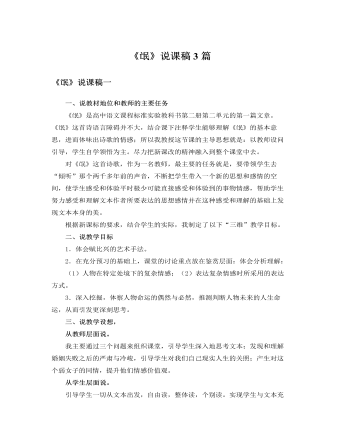
人教版高中语文必修2《氓》说课稿3篇
四、教学方法和学法。课前学生搜集有关《诗经》的资料必不可少。另外,时隔数千年,年代久远,文字的障碍很大,然而,过分纠缠于文字的疏通会破坏诗歌的“气”,丧失诗歌的“神”,所以在学习时,应舍去条分缕析的理论评价,指导学生结合注释疏通文字,然后引领他们经由文字再现形象和事件,经由形象和事件领略情感,感受其中浓浓的诗情。诵读的环节是重要的,配以二胡独奏《长相思》,营造意境,学生沉浸在音乐营造的意境中反复吟咏,读出节奏,读出音调,读出感情,细细体味,让或优或喜的情愫萦绕心间,我们就触到了先民的灵魂。比兴手法为《诗经》独创,重章叠句同样别致而新鲜,教学过程中结合具体语境让学生自己去发现并进行讨论,不搞枯燥的知识传授。还引入讲故事、改写两种活泼的学习形式,从而达到加深理解的目的。
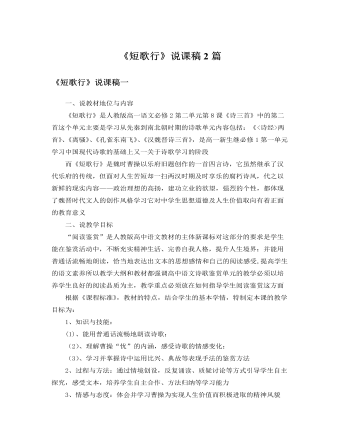
人教版高中语文必修2《短歌行》说课稿2篇
一、说教材《短歌行》是普通高中课程标准实验教科书必修(二)第二单元的一篇略读课文,本单元安排的是先秦到南北朝时期的诗歌。《短歌行》是著名政治家、军事家、文学家曹操的作品。诗中抓住“忧”字来写诗人为什么“忧”,如何解“忧”,从而表达希望能够招揽人才、完成统一天下的雄心壮志。所以本单元安排《短歌行》一诗,对学生全面了解曹操,感受曹操在短暂的人生中竭力创造伟业的气概。二、说学生我这一课的教学对象是高一学生。他们进入高中学习的时间只有三个多月,现在已经完成了必修(一)的学习。学习了现代诗歌单元,有了一定的诗歌学习基础,初步掌握了读诗的基本方法,但是还未能形成成熟的稳定的学习方式。同时,本单元学习是高中第一次接触古代诗歌,诗歌语言上的障碍和时间上的跨度对他们来说都是学习上的困难。因此教师要引导学生自主学习,合作学习,为他们设置新的学习情境,提供合作探究的机会。

人教版高中语文必修2《游褒禅山记》说课稿3篇
学法指导:高一学生对文言文阅读已具备了一些基础知识和积累,但对如何学习文言文,还是一个新课题,因此教师应引导学生掌握学习方法,运用已有的知识框架同化新信息,建立新的智能,逐步走向独立学习的境界。一、引导学生利用课文注释,使用工具书自己翻译,必要时教师进行点拨、解难,培养自学能力。二、告诉学生翻译文言文要遵循的原则。三、调动学生思考、讨论、交流的积极性,教师适时点拨,培养学生发现问题、解决问题的能力。四、提示学生反复诵读课文,体会文章所阐述的道理。五、鼓励学生及时归纳学习文言文的方法,注意积累文言文知识。教学程序:教学本课可安排2课时。第一课时:1、导入新课:首先给学生介绍毛泽东的七绝诗《为李进同志题所摄庐山仙人洞照》:“暮色苍茫看劲松,乱云飞渡仍从容。天生一个仙人洞,无限风光在险峰。”学生通过诵读领会了“无限风光在险峰”一句的含义。随后因势利导,引出课题,指出今天我们要学习的王安石的《游褒禅山记》,就含有类似的深邃哲理。
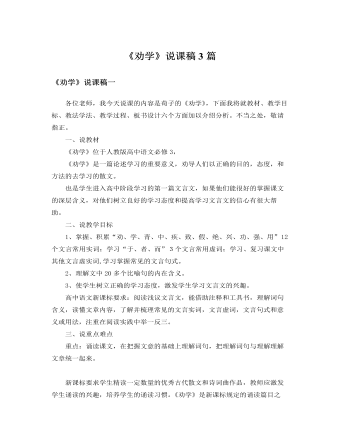
人教版高中语文必修3《劝学》说课稿3篇
《劝学》是普通高中课程标准试验教科书语文必修三第三单元的重点篇目,该文集中反映著名思想家荀子在学习问题上的观点和精彩斐然的论证艺术。该单元所选课文都是古代的议论性散文。通过本单元的学习在于让学生感受我国传统文化的精神,掌握基础的文言语法知识,学习如何清晰有力的表达自己的思想和见解。本文安排在单元的第一篇,如何指导学生学好这篇课文,是实现“授之以渔”,树立学生学好文言文的信心,掌握文言学习方法的关键。根据新课标倡导从“知识与能力”、“过程与方法”、“情感态度与价值观”三方面出发设计课程目标的要求和高一的学生对于文言文的知识还在积累的阶段,应该注重基础知识的积累和一定量的诵读的实际情况。我拟确定以下教学目标:1,了解荀子论述学习的思想,明确学习要靠积累、坚持不懈、专心致志的道理。2,掌握积累文言实词、虚词,活用、古今异议等现象和固定句式。